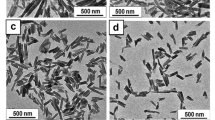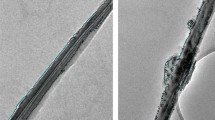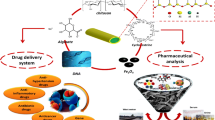Abstract
Recently, naturally occurring and abundantly available halloysite nanoclay has emerged as a nanomaterial carrier system suitable for both controlled and sustained delivery. These aluminosilicate tubes of 50-nm diameter, with outer silica and inner alumina layers, possess a tubular structure, with excellent features such as large aspect ratio, good biocompatibility, and high mechanical strength entails them to be suitable for drug delivery. The unique features of these nanotubes are the ability to load DNA and enzyme due to opposite charges on both inner and outer surfaces which allow selective drug loading on both surfaces. This review article emphasizes on the drug loading techniques with release characteristics and some important applications in biomedical, environmental fields, and different types of medication. Being most versatile, these nanotubes can be used widely as a carrier system for enzyme bases and different types of the nucleus which can be a most promising step for novel drug delivery systems.

Similar content being viewed by others
References
Tjong, S. C. (2006). Structural and mechanical properties of polymer nanocomposites. Materials Science and Engineering, 53(3–4), 73–197.
Kashiwagi, T., Du, F., Douglas, J. F., Winey, K. I., & Harris Jr., R. H. (2005). Nanoparticle networks reduce the flammability of polymer nanocomposites. Nature Materials, 4(12), 928–933.
Ramanathan, T., Abdala, A., Stankovich, S., Dikin, D., Herrera-Alonso, M., Piner, R., & Adamson, D. (2008). Functionalized graphene sheets for polymer nanocomposites. Nature Nanotechnology, 3(6), 327–331.
Lvov, Y., & Abdullayev, E. (2013). Functional polymer–clay nanotube composites with sustained release of chemical agents. Progress in Polymer Science, 38(10–11), 1690–1719.
Liu, M., Jia, Z., Jia, D., & Zhou, C. (2014). Recent advance in research on halloysite nanotubes- polymer nanocomposite. Progress in Polymer Science, 39(8), 1498–1525.
Brindley, G. W. (1955). Structural mineralogy of clays. Clays and Clay Technology, 169(8), 33–44.
Hanif, M., Jabbar, F., Sharif, S., Assas, G., Farooq, A., & Aziz, M. (2016). Halloysite nanotubes as a new drug-delivery system: A review. Clay Minerals, 51(2), 469–477.
Brindley, G. W., & Robinson, K. (1948). X-ray studies of halloysite and metahalloysite, I: The structure of metahalloysite, an example of random layer lattice. Mineralogical Magazine, 28(203), 393–406.
Briggati, M. F., Galan, E., & Theng, B. K. G. (2006). Structures and mineralogy of clay minerals. In F. Bergaya, B. K. G. Theng, & G. Lagaly (Eds.), Handbook of Clay Science (pp. 19–86). Amsterdam, 1: Elsevier.
Wilson, I., & Keeling, J. (2016). Global occurrence geology and characteristics of tubular halloysite deposits. Clay Minerals, 51(3), 309–324.
Churchman, G. J., & Theng, B. K. G. (1984). Interactions of halloysites with amides: Mineralogical factors affecting complex formation. Clay Minerals, 19(2), 161–175.
Churchman, G. J., & Theng, B. K. G. (2006). Clay research in Australia and New Zealand. Applied Clay Science, 1, 625–675.
Perruchot, A., Dupuis, C., Brouard, E., Nicaise, D., & Ertus, R. (1997). Halloysitekarstique: comparaison des gisements types de Wallonie (Belgique) et du Perigord (France). Clay Minerals, 32(2), 271–287.
Kloprogge, J. T., & Frost, R. L. (1999). Raman microprobe spectroscopy of hydrated halloysite from a neogenecryptokarst from Southern Belgium. Journal of Raman Spectroscopy, 30, 1079–1085.
Papoulis, D., Komarneni, S., & Panagiotaras, D. (2014). Geochemistry of halloysite-7 Å formation from plagioclase in trachyandesite rocks from Limnos Island, Greece. Clay Minerals, 49(1), 75–89.
Veerabadran, N. G., Mongayt, D., Torchilin, V., Price, R. R., & Lvov, Y. M. (2009). Organized shell on clay nanotubes for controlled release of macromolecules. Macromolecular Rapid Communications, 30(2), 99–103.
Abdullayev, E., & Lvov, Y. (2011). Halloysite clay nanotubes for controlled release of protective agents. Journal of Nanoscience and Nanotechnology, 11(11), 10007–10026.
Du, M., Guo, B., & Jia, D. (2010). Newly emerging applications of halloysite nanotubes: A review. Polymer International, 59, 574–582.
Chao, C., Liu, J., Wang, J., Zhang, Y., Zhang, B., Zhang, Y., et al. (2013). Surface modification of halloysite nanotubes with dopamine for enzyme immobilization. ACS Applied Materials & Interfaces, 5(21), 10559–10564.
Lvov, Y., Wang, W., Zhang, L., & Fakhrullin, R. (2016). Halloysite clay nanotubes for loading and sustained release of functional compounds. Advanced Materials, 28(6), 1227–1250.
Abdullayev, E., Price, R., Shchukin, D., & Lvov, Y. (2009). Halloysite tubes as nanocontainers for anticorrosion coating with benzotriazole. ACS Applied Materials & Interfaces, 1, 1437–1443.
Berthier, P. (2004). Analyse de l’halloysit. Annales de Chimie Physique, 32, 332–335.
Bates, T. F., Hildebrand, F. A., & Swineford, A. (1950). Morphology and structure of endellite and halloysite. American Mineralogist, 35, 463–484.
Joussein, E., Petit, S., Churchman, J., Theng, B., Righi, D., & Delvaux, B. (2005). Halloysite clay minerals–a review. Clay Minerals, 40(4), 383–426.
Handge, U. A., Hedicke-Höchstötter, K., & Altstädt, V. (2010). Composites of polyamide 6 and silicate nanotubes of the mineral halloysite: Influence of molecular weight on thermal, mechanical and rheological properties. Polymer, 51, 2690–2699.
Liu, M., Zhang, Y., & Zhou, C. (2013). Nanocomposites of halloysite and polylactide. Applied Clay Science, 75, 52–59.
Veerabadran, N. G., Price, R. R., & Lvov, Y. M. (2007). Clay nanotubes for encapsulation and sustained release of drugs. NANO: Brief Reports and Reviews, 2, 115–120.
Abdullayev, E., Joshi, A., Wei, W., Zhao, Y., & Lvov, Y. (2012). Enlargement of halloysite clay nanotube lumen by selective etching of aluminum oxide. American Chemical Society Nano, 6(8), 7216–7226.
Riela, S., Massaro, M., Colleti, C. G., Bommarito, A., Giordano, C., Noto, R., Poma, P., & Lazzara, G. (2014). Development and characterization of co-loaded curcumin/triazole halloysite systems and evaluation of their potential anticancer activity. International Journal of Pharmaceutics, 475, 613–623.
Massaro, M., Amorati, R., Cavallaro, G., Guernelli, S., Lazzara, G., Milioto, S., Noto, R., Poma, P., & Riela, S. (2016). Direct chemical grafted curcumin on halloysite nanotubes as dual-responsive prodrug for pharmacological applications. Colloids and Surfaces B: Biointerfaces, 140, 505–513.
Price, R. R., Gaber, B. P., & Lvov, Y. (2001). In-vitro release characteristics of tetracycline HCL, khellin and nicotinamide adenine dineculeotide from halloysite; a cylindrical mineral. Journal of Microencapsulation, 18(6), 713–722.
Shi, Y., Tian, Z., Zhang, Y., Shen, H., & Jia, N. (2011). Functionalized halloysite nanotube-based for intracellular delivery of antisense oligonucleotides. Nanoscale Research Letters, 6(1), 1–7.
Yah, W. O., Xu, H., Soejima, H., Ma, W., Lvov, Y., & Takahara, A. (2012). Biomimetic dopamine derivative for selective polymer modification of halloysite nanotube lumen. Journal of the American Chemical Society, 134(29), 12134–12137.
Cavallaro, G., Lazzara, G., & Milioto, S. (2012). Exploiting the colloidal stability and solubilization ability of clay nanotubes/ionic surfactant hybrid nanomaterials. The Journal of Physical Chemistry C, 116(41), 21932–21938.
Patel, S., Jammalamadaka, U., Sun, L., Tappa, K., & Mills, D. K. (2016). Sustained release of antibacterial agents from doped halloysite nanotubes. Bioengineering, 3(1), 1–14.
Fan, L., Zhang, J., & Wang, A. (2013). In situ generation of sodialginate/hydroxyapatite/halloysite nanotubes composite hydrogel beads as drug-controlled release matrices. Journal of Materials Chemistry B, 45, 6261–6270.
Massaro, M., Colletti, C. G., Noto, R., Riela, S., Poma, P., Guernelli, S., Parisi, F., Milioto, S., & Lazzara, G. (2015). Pharmaceutical properties of supramolecular assembly of co-loaded cardanol/triazole-halloysite systems. International Journal of Pharmaceutics, 478(2), 476–485.
Tully, J., Yendluri, R., & Lvov, Y. (2016). Halloysite clay nanotubes for enzyme immobilization. Biomacromolecules, 17(2), 615–621.
Lun, H., Ouyang, J., & Yang, H. (2014). Natural halloysite nanotubes modified as an aspirin carrier. The Royal Society of Chemistry Advances, 4, 44197–44202.
Sun, J., Yendluri, R., Lui, K., Guo, Y., Lvov, Y., & Yan, X. (2017). Enzyme-immobilized clay nanotubes chitosan membranes with sustained biocatalytic activities. Physical Chemistry Chemical Physics, 19(1), 562–567.
Dzamukova, M. R., Naumenko, E. A., Lvov, Y. M., & Fakhrullin, R. F. (2015). Enzyme-activated intracellular drug delivery with tubule clay nano formulation. Scientific Reports, 5, 10560–10566.
Lazzara, G., Riela, S., & Fakhrullin, R. F. (2007). Clay-based drug delivery systems: What does the future hold? NANO: Brief Reports and Reviews, 2, 115–120.
Liu, M., Guo, B., Du, M., Cai, X., & Jia, D. (2007). Properties of halloysite nanotube–epoxy resin hybrids and the interfacial reactions in the systems. Nanotechnology, 18(45), 455703.
Carroll, D., & Starkey, H. C. (1971). Reactivity of clay minerals with acids and alkalis. Clay Minerals, 19(5), 321–333.
Korsmeyer, R. W., Gurny, R., Doelker, E., Buri, P., & Peppas, N. A. (1983). Mechanisms of solute release from porous hydrophilic polymers. International Journal of Pharmaceutics, 15(1), 25–35.
Abdullayev, E., & Lvov, Y. (2013). Halloysite clay nanotubes as a ceramic “skeleton” for functional biopolymer composites with sustained drug release. Journal of Materials Chemistry B, 1, 2894–2903.
Wei, W., Minullina, R., Abdullayev, E., Fakhrullin, R., Mills, D., & Lvov, Y. (2014). Enhanced efficiency of antiseptics with sustained release from clay nanotubes. RCS Advances, 4, 488–494.
Wei, W., Abdullayev, E., Hollister, A., Lvov, Y., & Mills, D. (2012). Clay nanotube/poly(methyl methacrylate) bone cement composite with sustained antibiotic release. Macromolecular Materials and Engineering, 297(7), 645–653.
Aguzzi, C., Viseras, C., Cerezo, P., Salcedo, I., Sa’nchez-Espejo, R., & Valenzuela, C. (2013). Release kinetics of 5-aminosalicylic acid from halloysite. Colloidal Surface B Biointerfaces, 105, 75–80.
Lvov, Y., & Price, R. (2008). Halloysite nano tubules a novel substrate for the controlled delivery of bioactive molecules. In E. Ruiz-Hitzky, K. Ariga, & Y. Lvov (Eds.), Bio-inorganic hybrid nanomaterials (pp. 440–478). London: Wiley.
Vergaro, V., Abdullayev, E., Lvov, Y. M., Zeitoun, A., Cingolani, R., Rinaldi, R., & Leporatti, S. (2010). Cytocompatibility and uptake of halloysite clay nanotubes. Biomacromolecules, 11(3), 820–826.
Liu, M., Chang, Y., Yang, J., You, Y., He, R., Chen, T., & Zhou, C. (2016). Functionalized Halloysite nanotube by chitosan grafting for drug delivery of curcumin to achieve enhanced anticancer efficacy. Journal of Materials Chemistry B, 4(13), 2253–2263.
Hughes, A. D., & King, M. R. (2010). Use of naturally occurring halloysite nanotubes for enhanced capture of flowing cells. Langmuir, 26(14), 12155–12164.
He, R., Liu, M., Shen, Y., Long, Z., & Zhou, C. (2017). Large-area assembly of halloysite nanotubes for enhancing the capture of tumor cells. Journal of Materials Chemistry B, 5(9), 1712–1723.
Wu, Y., Yang, J., & Gao, H. (2017). Folate conjugated halloysite nanotubes an efficient drug carrier deliver doxorubicin fir targeted therapy of breast cancer. ACS Applied Nanomaterials, 1(2), 595–608.
Long, Z., Zhang, J., Shen, Y., & Liu, M. (2017). Polyethyleneimine grafted short halloysite nanotubes for gene delivery. Materials Science and Engineering: C, 81, 224–235.
Zhao, M., & Liu, P. (2008). Adsorption behavior of methylene blue on halloysite nanotubes. Microporous and Mesoporous Materials, 112(1–3), 419–424.
Peng, Q., Liu, M., Zheng, J., & Zhou, C. (2015). Adsorption of dyes in aqueous solutions by chitosan–halloysite nanotubes composite hydrogel beads. Microporous and Mesoporous Materials, 201, 190–201.
Shchukin, D. G., Sukhorukov, G. B., Price, R. R., & Lvov, Y. M. (2005). Halloysite nanotubes as biomimetic nanoreactors. Small, 1(5), 510–513.
Abdullayev, E., Sakakibara, K., Okamoto, K., Wei, W., Ariga, K., & Lvov, Y. (2011). Natural tubule clay template synthesis of silver nanorods for antibacterial composite coating. ACS Applied Materials & Interfaces, 3(10), 4040–4046.
Rostamzadeh, T., Islam Khan, M. S., Riché, K., Lvov, Y. M., Stavitskaya, A. V., & Wiley, J. B. (2017). Rapid and controlled in situ growth of noble metal nanostructures within halloysite clay nanotubes. Langmuir, 33(45), 13051–13059.
Makaremi, M., Pasbakhsh, P., Cavallaro, G., Lazzara, G., Aw, Y. K., Lee, S. M., & Milioto, S. (2017). Effect of morphology and size of halloysite nanotubes on functional pectin bio nanocomposites for food packaging applications. ACS Applied Materials & Interfaces, 9(20), 17476–17488.
Zeng, G., He, Y., Zhan, Y., Zhang, L., Shi, H., & Yu, Z. (2016). Preparation of a novel poly (vinylidene fluoride) ultrafiltration membrane by incorporation of 3-aminopropyltriethoxysilane-grafted halloysite nanotubes for oil/water separation. Industrial and Engineering Chemistry Research, 55(6), 1760–1767.
Riedlinger, M., & Corkery, R. (2007). Cosmetic skincare applications employing mineral-derived tubules for controlled release, in Google patents. United States: Natural nanotechnology Inc..
Kurczewska, J., Pecyna, P., Ratajczak, M., Gajecka, M., & Schroeder, G. (2017). Halloysite nanotubes as carriers of Vancomycin in alginate-based wound dressing. Saudi Pharmaceutical Journal, 25(6), 911–920.
Yendluri, R., Lvov, Y., Devilliers, M., Vinokurov, V., Naumenko, E., Tarasova, E., & Fakhurullin, R. (2017). Paclitaxel encapsulated in halloysite clay nanotubes for intestinal and intracellular delivery. Journal of Pharmaceutical Sciences, 106(10), 3131–3139.
Tang, X., Li, L., Shen, B., & Wang, C. (2013). Halloysite-nanotubes supported FeNi alloy nanoparticles for catalytic decomposition of toxic phosphine gas into yellow phosphorus and hydrogen. Chemosphere, 91(9), 1368–1373.
Liu, P., & Zhao, M. (2009). Applied surface science silver nanoparticle supported on Halloysite nanotubes catalyzed reduction of 4-nitrophenol (4-NP). Applied Surface Science, 255(7), 3989–3993.
Zhang, A., Liu, S., Yan, K., Ye, Y., & Chen, X. (2014). Facile preparation of MnFe2O4/Halloysite nanotubular encapsulates with enhanced magnetic and electromagnetic performances. RSC Advances, 4(26), 13565–13568.
Zhang, Y., Chen, Y., Zhang, H., Zhang, B., & Liu, J. (2013). Potent antibacterial activity of a novel silver nanoparticle-halloysite nanotube nanocomposite powder. Journal of Inorganic Biochemistry, 118, 59–64.
Marney, D. C. O., Russell, L. J., Wu, D. Y., Nguyen, T., Cramm, D., Rigopoulos, N., & Wright, N. (2008). The suitability of halloysite nanotubes as a fire retardant for nylon 6. Polymer Degradation and Stability, 93, 1971–1978.
Kamble, R., Ghag, M., Gaikawad, S., & Panda, B. K. (2012). Halloysite nanotubes and applications: A review. Journal of Advanced Scientific Research, 3(2), 25–29.
Thakur, P., Kool, A., Bagchi, B., Das, S., & Nandy, P. (2014). Enhancement of β phase crystallization and dielectric behavior of kaolinite/halloysite modified poly(vinylidenefluoride) thin films. Applied Clay Science, 99, 149–159.
Zhou, X., Li, K., Tu, R., Yi, J., Xie, Q., & Jiang, X. (2016). A modelling study of the multiphase leakage flow from pressurised CO2 pipeline. Journal of Hazardous Materials, 306, 286–294.
Zhang, L., Wang, T., & Liu, P. (2008). Polyaniline-coated halloysite nanotubes via in-situ chemical polymerization. Applied Surface Science, 255, 2091–2097.
Levis, S. R., & Deasy, P. B. (2002). Characterisation of halloysite for use as a microtubular drug delivery system. International Journal of Pharmaceutics, 243(1–2), 125–134.
Zhao, X., Fu, X., & Wan, Q. (2017). The toxicity evaluation of one dimensional nanoparticles using caenorhabditis elegance: A comparative study of HNT and chitin nanocrystals. ACS Sustainable Chemistry & Engineering, 7(23), 18965–18975.
Long, Z., Wu, Y. P., Gao, H. Y., Zhang, J., & He, R. R. (2018). Invivo toxicity evaluation of HNT. Journal of Materials Chemistry B, 6(44), 7204–7216.
Acknowledgements
The authors are grateful to the Pranveer Singh Institute of Technology, Department of Pharmacy, Kanpur, India, for the support and facilities during preparation of manuscript.
Author information
Authors and Affiliations
Corresponding author
Ethics declarations
Conflict of Interest
The authors declare no conflict of interest, financial or otherwise.
Research Involving Humans and Animals Statement
This review does not contain any studies with animal/human subjects by any of the authors.
Informed Consent
None.
Additional information
Publisher’s Note
Springer Nature remains neutral with regard to jurisdictional claims in published maps and institutional affiliations.
Rights and permissions
About this article
Cite this article
Kushwaha, S.K.S., Kushwaha, N., Pandey, P. et al. Halloysite Nanotubes for Nanomedicine: Prospects, Challenges and Applications. BioNanoSci. 11, 200–208 (2021). https://doi.org/10.1007/s12668-020-00801-6
Accepted:
Published:
Issue Date:
DOI: https://doi.org/10.1007/s12668-020-00801-6




